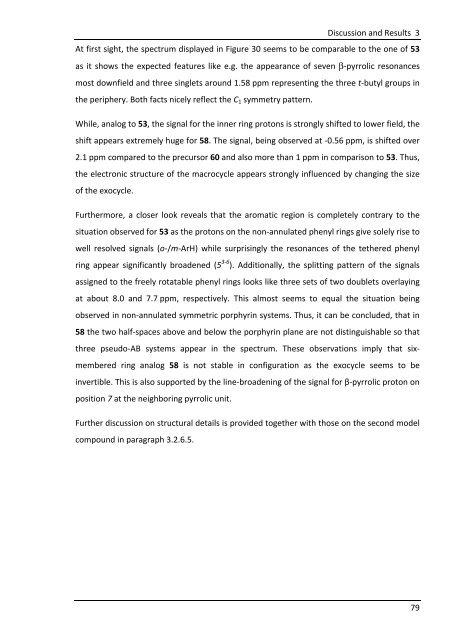1.1 Porphyrins - Friedrich-Alexander-Universität Erlangen-Nürnberg
1.1 Porphyrins - Friedrich-Alexander-Universität Erlangen-Nürnberg
1.1 Porphyrins - Friedrich-Alexander-Universität Erlangen-Nürnberg
You also want an ePaper? Increase the reach of your titles
YUMPU automatically turns print PDFs into web optimized ePapers that Google loves.
Discussion and Results 3<br />
At first sight, the spectrum displayed in Figure 30 seems to be comparable to the one of 53<br />
as it shows the expected features like e.g. the appearance of seven β-pyrrolic resonances<br />
most downfield and three singlets around 1.58 ppm representing the three t-butyl groups in<br />
the periphery. Both facts nicely reflect the C1 symmetry pattern.<br />
While, analog to 53, the signal for the inner ring protons is strongly shifted to lower field, the<br />
shift appears extremely huge for 58. The signal, being observed at -0.56 ppm, is shifted over<br />
2.1 ppm compared to the precursor 60 and also more than 1 ppm in comparison to 53. Thus,<br />
the electronic structure of the macrocycle appears strongly influenced by changing the size<br />
of the exocycle.<br />
Furthermore, a closer look reveals that the aromatic region is completely contrary to the<br />
situation observed for 53 as the protons on the non-annulated phenyl rings give solely rise to<br />
well resolved signals (o-/m-ArH) while surprisingly the resonances of the tethered phenyl<br />
ring appear significantly broadened (5 3-6 ). Additionally, the splitting pattern of the signals<br />
assigned to the freely rotatable phenyl rings looks like three sets of two doublets overlaying<br />
at about 8.0 and 7.7 ppm, respectively. This almost seems to equal the situation being<br />
observed in non-annulated symmetric porphyrin systems. Thus, it can be concluded, that in<br />
58 the two half-spaces above and below the porphyrin plane are not distinguishable so that<br />
three pseudo-AB systems appear in the spectrum. These observations imply that six-<br />
membered ring analog 58 is not stable in configuration as the exocycle seems to be<br />
invertible. This is also supported by the line-broadening of the signal for β-pyrrolic proton on<br />
position 7 at the neighboring pyrrolic unit.<br />
Further discussion on structural details is provided together with those on the second model<br />
compound in paragraph 3.2.6.5.<br />
79

















